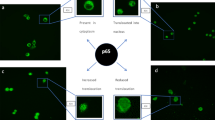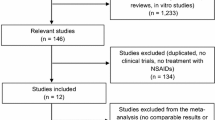Abstract
The newly introduced cyclo-oxygenase-2 (COX-2) inhibiting nonsteroidal anti-inflammatory drugs (NSAIDs) have been established as effective agents in treating arthritic conditions, while greatly reducing the gastrointestinal adverse effects of traditional NSAIDs. There are expectations that NSAIDs will be useful in the treatment of Alzheimer’s disease (AD), and that COX-2 inhibitors might have a role. However, a recently reported clinical trial of a COX-2 inhibitor in AD indicated that it was neither protective nor did it accelerate the decline. The expectations were based on pathological evidence of inflammatory changes associated with AD lesions and epidemiological evidence of a reduced prevalence of AD in populations taking NSAIDs. They were supported by preliminary evidence showing efficacy of NSAIDs in treating patients with AD. These data are based on the use of traditional NSAIDs.
Whether COX-2 inhibitors would be similarly effective was uncertain since COX-2 is constitutively expressed in neurons. Animal experiments suggest that COX-2 may be performing adaptive functions associated with normal neurons and protective functions associated with stressed neurons. These results emphasise that the appropriate target for NSAID trials in AD is COX-1, but they also indicate that there would be no contraindication to the use of those traditional NSAIDs which have mixed COX-l/COX-2 inhibiting activity.




Similar content being viewed by others
References
McGeer PL, McGeer EG. The inflammatory response system of brain: implications for therapy of Alzheimer and other neurodegenerative diseases. Brain Res Rev 1995; 21: 195–218
McGeer PL, Schulzer M, McGeer EG. Arthritis and anti-inflammatory agents as possible protective factors for Alzheimer’s disease: a review of 17 epidemiological studies. Neurology 1996; 47: 425–32
Stewart WF, Kawas C, Corrada M, et al. Risk of Alzheimer’s disease and duration of NSAID use. Neurology 1997 March; 48: 626–32
Robitaille A. Improved nonsteroidal anti-inflammatories. Can J Contin Med Educ 1998 July: 85–97
Steering Committee of the Physicians’ Health Study Research Group. Preliminary report: findings from the aspirin component of the ongoing physicians’ health study. N Engl J Med 1988; 318: 262–4
Lane NE. Pain management in osteoarthritis: the role of COX-2 inhibitors. J Rheumatol 1997; 24Suppl. 49: 20–4
Lipsky PE, Isakson PC. Outcome of specific COX-2 inhibition in rheumatoid arthritis. J Rheumatol 1997; 24Suppl. 49: 9–14
Wilcox CM, Shalek KA, Cotsonsis G. Striking prevalence of over the counter nonsteroidal anti-inflammatory drug use in patients with upper gastrointestinal hemorrhage. Arch Intern Med 1994; 154(1): 42–6
Mackenzie IRA, Munoz DG. Nonsteroidal anti-inflammatory drug use and Alzheimer-type pathology in aging. Neurology 1998 April; 50: 986–90
Mackenzie IRA. Anti-inflammatory drugs and Alzheimer type pathology in aging. Neurology 2000; 54: 732–4
Beard CM. Kokmen E, Kurland LT. Rheumatoid arthritis and susceptibility to Alzheimer’s disease [letter]. Lancet 1991; 337: 1426
Breitner JCS, Welsh KA, Helms MJ, et al. Delayed onset of Alzheimer’s disease with nonsteroidal anti-inflammatory and histamine H2 blocking drugs. Neurobiol Aging 1995; 16(4): 523–30
Rich JB, Rasmusson DX, Folstein MF et al. Nonsteroidal antiinflammatory drugs in Alzheimer’s disease. Neurology 1995 Jan; 45: 51–5
Rogers J, Kirby LC, Hempelman SR, et al. Clinical trial of indomethacin in Alzheimer’s disease. Neurology 1993 Aug; 43: 1609–11
Scharf S, Mander A, Ugoni A, et al. A double-blind, placebo-controlled trial of diclofenac misoprostol in Alzheimer’s disease. Neurology 1999 Jul; 53(1): 197–201
Sainali SM, Ingram DM, Talwaker S, et al. Results of a double-blind, placebo-controlled study of celecoxib in the treatment of progression of Alzheimer’s disease [abstract]. 6th International Stockholm-Springfield Symposium of Advances in Alzheimer Therapy; 2000 Apr 5–8; Stockholm
Vane JR. Inhibition of prostaglandin synthesis as a mechanism of action for aspirin-like drugs. Nat New Biol 1971; 231: 232–5
Crofford LJ. COX-1 and COX-2 tissue expression: implications and predictions. J Rheumatol 1997; 24Suppl. 49: 15–9
Smith WL, Garavito RM, DeWitt DL. Prostaglandin endoper-oxide H synthases (cyclooxygenases)-1 and -2. J Biol Chem 1996 Dec 27; 271(52): 33157–60
Hawkey CJ. COX-2 inhibitors. Lancet 1999 Jan 23; 353: 307–13
Yasojima K, Schwab C, McGeer EG, et al. Distribution of cyclooxygenase-1 and cyclooxygenase-2 mRNAs and proteins in human brain and peripheral organs. Brain Res 1999; 830: 226–36
Morris JK, Richards JS. An E-box region within the prostaglandin endoperoxide synthase-2 (PGS-2) promoter is required for transcription in rat ovarian granulosa cells. J Biol Chem 1996 July 12; 271(28): 16633–43
Morham SG, Langenbach R, Loftin CD, et al. Prostaglandin synthase 2 gene disruption causes severe renal pathology in the mouse. Cell 1995 Nov 3; 83: 473–82
Dinchuk JE, Car BD, Focht RJ, et al. Renal abnormalities and an altered inflammatory response in mice lacking cyclo-oxygenase II. Nature 1995 Nov 23; 378: 406–9
Langenbach R, Morham SG, Tiano HF, et al. Prostaglandin synthase 1 gene disruption in mice reduces arachidonic acid-induced inflammation and indomethacin-induced gastric ulceration. Cell 1995 Nov 3; 83: 483–92
Wallace JL, Chin BC. New generation NSAIDs: the benefits without the risks. Drugs Today 1997 Jul–Aug; 33(6): 371–8
Schumann P, Touzani O, Young AR, et al. Effects of indomethacin on cerebral blood flow and oxygen metabolism: a positron emission tomographic investigation in the anesthetized baboon. Neurosci Lett 1996; 220: 137–41
Reuter BK, Asfaha S, Buret A, et al. Exacerbation of inflammation-associated colonic injury in rats through inhibition of cyclooxygenase-2. J Clin Invest 1996 Nov; 98(9): 2076–85
Kaufmann WE, Andreason KI, Isakson PC, et al. Cyclooxygenases and the central nervous system. Prostaglandins 1997 Sept; 54: 601–24
Kaufmann WE, Worley PF, Pegg J, et al. COX-2, a synaptically-induced enzyme, is expressed by excitatory neurons at postsynaptic sites in rat cerebral cortex. Proc Natl Acad Sci U S A 1996 March; 93: 2317–21
Adams J, Collaco-Moraes Y, de Belleroche J. Cyclooxygenase-2 induction in cerebral cortex: an intracellular response to synaptic excitation. J Neurochem 1996; 66(1): 6–13
Yamagata K, Andreasson KI, Kaufmann WE, et al. Expression of a mitogen-inducible cyclooxygenase in brain neurons: regulation by synaptic activity and glucocorticoids. Neuron 1993 Aug; 11: 371–86
Baik EJ, Kim EJ, Lee SH, et al. Cyclooxygenase-2 selective inhibitors aggravate kainic acid induced seizure and neuronal cell death in the hippocampus. Brain Res 1999; 843: 118–29
Ho L, Osaka H, Aisen PS, et al. Induction of cyclooxygenase (COX)-2 but not COX-1 gene expression in apoptotic cell death. J Neuroimmunol 1998; 89: 142–9
Walton M, Sirimanne E, Williams C, et al. Prostaglandin H synthase-2 and cytosolic phospholipase A(2) in the hypoxic-ischemic brain: role in neuronal survival. Mol Brain Res 1997 Oct 15; 50(1-2): 165–70
Planas AM, Soriano MA, Justicia C, et al. Induction of cyclooxygenase-2 in the rat brain after a mild episode of focal ischemia without tissue inflammation or neural cell damage. Neurosci Lett 1999; 275: 141–4
Nakayama M, Uchimura K, Zhu RL, et al. Cyclooxygenase-2 inhibition prevents delayed death of CA1 hippocampal neurons following global ischemia. Proc Natl Acad Sci USA 1998 Sept 1; 95(18): 10954–9
Nogawa S, Zhang FY, Ross ME, et al. Cyclooxygenase-2 gene expression in neurons contributes to ischemic brain damage. J Neurosci 1997 Apr 15; 17(8): 2746–55
Hara K, Kong DL, Sharp FR, et al. Effect of selective inhibitors of cyclooxygenase-2 on temporary focal cerebral ischemia in rats. Neurosci Lett 1998; 256: 53–6
Buccellati C, Folco GC, Sala A, et al. Inhibition of prostanoid synthesis protects against neuronal damage induced by focal ischemia in rat brain. Neurosci Lett 1998; 257: 123–6
Inoue H, Yokoyama C, Hara S, et al. Transcriptional regulation of human prostaglandin-endoperoxide synthase-2 gene by lipopolysaccharide and phorbol ester in endothelial cells. J Biol Chem 1995 Oct 20; 270(42): 24965–71
Lacroix S, Rivest S. Effect of acute systemic inflammatory response and cytokines on the transcription of the genes encoding cyclooxygenase enzymes (COX-1 and COX-2) in the rat brain. J Neurochem 1998 Feb; 70(2): 452–66
Cao C, Matsumura K, Yamagata K, et al. Endothelial cells of the rat brain vasculature express cyclooxygenase-2 mRNA in response to systemic interleukin-1 beta: a possible site of prostaglandin synthesis responsible for fever. Brain Res 1996 Sept 16; 733(2): 263–72
Ichitani Y, Shi T, Haeggstrom JZ, et al. Increased levels of cyclooxygenase-2 mRNA in the rat spinal cord after peripheral inflammation: an in situ hybridization study. Neuroreport 1997 Sept 8; 8(13): 2949–52
Chan CC, Boyce S, Brideau C, et al. Rofecoxib [Vioxx, MK-0966; 4-(4′-methylsulfonylphenyl)-3-phenyl-2-(5H)-fura-none]: a potent and orally active cyclooxygenase-2 inhibitor. Pharmacological and biochemical profiles. J Pharmacol Exp Ther 1999; 290(2): 551–60
Penning TD, Talley JJ, Bertenshaw ST, et al. Synthesis and biological evaluation of the 1,5-diarylpyrazole class of cyclooxygenase-2 inhibitors: identification of 4-5-(4-methylphe-nyl)-3-(trifluoromethyl)-lH-pyrazol-l-yl]benzenesulfonam ide (SC-58635, Celecoxib). J Med Chem 1997; 40: 1347–65
Engelhardt G, Bogel R, Schnitzer C, et al. Meloxicam: influence on arachidonic acid metabolism. Biochem Pharmacol 1996; 51: 21–8
Vane JR, Botting RM. New insights into the mode of action of anti-inflammatory drugs. Inflamm Res 1995; 44: 1–10
Meade EA, Smith WL, DeWitt DL. Differential inhibition of prostaglandin endoperoxide synthase (cyclo-oxygenase) iso-enzymes by aspirin and other non-steroidal anti-inflammatory drugs. J Biol Chem 1993 March 25; 268(9): 6610–4
Masferrer JL, Zweifel BS, Manning PT, et al. Selective inhibition of inducible cyclooxygenase 2 in vivo is anti-inflammatory and nonulcerogenic. Proc Natl Acad Sci U S A 1994 April; 91: 3228–32
Landfield PW, Eldridge JC. Increasing affinity of type II corticosteroid binding in aged rat hippocampus. Exp Neurol 1989; 106: 110–3
Aisen PS, Davis KL, Berg JD, et al. A randomized controlled trial of prednisone in Alzheimer’s disease. Neurology 2000; 54: 588–93
Acknowledgements
Our work on Alzheimer disease has been supported by grants from the Alzheimer Societies of British Columbia and Canada, and the Jack Brown and Family A.D. Research Fund, as well as donations from individual British Columbians.
Author information
Authors and Affiliations
Corresponding author
Rights and permissions
About this article
Cite this article
McGeer, P.L. Cyclo-Oxygenase-2 Inhibitors. Drugs & Aging 17, 1–11 (2000). https://doi.org/10.2165/00002512-200017010-00001
Published:
Issue Date:
DOI: https://doi.org/10.2165/00002512-200017010-00001




